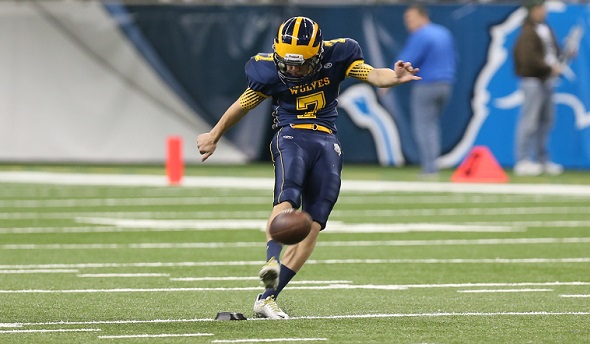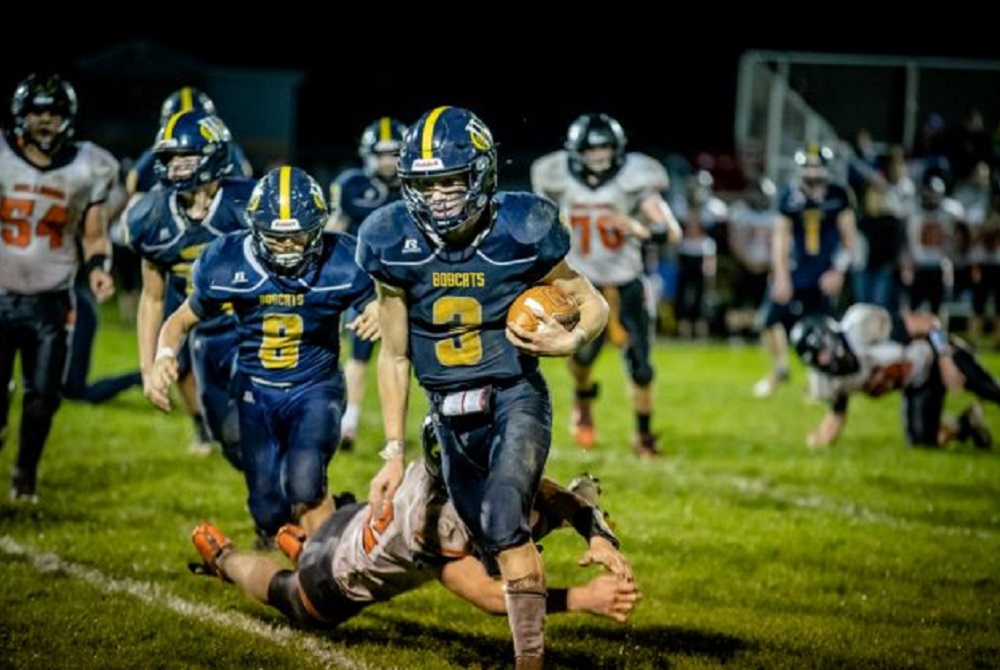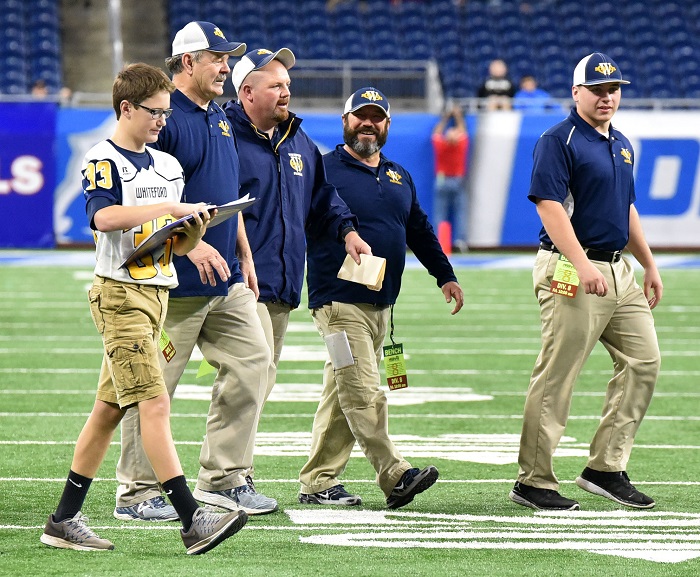
Catch These New Rules as Fall Kicks Off
August 7, 2014
By Geoff Kimmerly
Second Half editor
The first practices of 2014-15 begin next week for approximately 110,000 student-athletes taking part in eight sports in which the Michigan High School Athletic Association sponsors postseason tournaments, with nearly 41,000 football players practicing under a new policy in that sport aimed at continuing to improve player safety.
The new practice policy was proposed by a Football Task Force made up of coaches, administrators and MHSAA staff which met during 2012 and 2013, and approved by the MHSAA’s Representative Council at its Winter Meeting on March 21.
The modifications are meant to promote heat acclimatization and limit helmet-to-helmet contact during practices. They include:
- During the first week of practice, only helmets are allowed the first two days, only shoulder pads may be added on the third and fourth days, and full pads may not be worn until the fifth day of team practice.
- Before the first regular-season game, schools may not schedule more than one “collision” practice in a day. A collision practice is defined as one in which there is live, game-speed, player-versus-player contact in pads involving any number of players.
- After the first regular-season game, teams may conduct no more than two collision practice days in any week, Monday through Sunday.
- No single football practice may exceed three hours, and the total practice time for days with multiple practice sessions may not exceed five hours. Neither strength/weight training activities nor video/classroom sessions are considered practice for the purposes of the three or five-hour limits.
Previously, schools were required to conduct at least three days of practice without pads before beginning contact. The change to four days for gradual addition of pads was added to assist athletes in acclimating to being physically active in hot weather. Guidelines reducing the amount of collision practice go hand in hand with rules changes that have been made to reduce helmet-to-helmet contact in game situations. The policies in detail can be found on the Football page of the MHSAA Website.
“We think these new policies, with respect to the number of collision practices there can be before the first game, and after the first game, really are where 85 to 90 percent of our coaches already were,” said John E. “Jack” Roberts, executive director of the MHSAA. “This new policy sends a signal to that 10 to 15 percent to get on board with the rest of us to make football just as safe as it can possibly be.”
Practice in football must begin on August 11 for all schools wishing to begin regular-season games the weekend of August 28-30. Schools must have 12 days of preseason practice at all levels before their first game, and those 12 days of practice may not occur before 16 calendar days.
Practice sessions for all other sports begin on Wednesday (August 13). In golf and tennis, competition may commence no earlier than after three separate days of team practice, and not before seven calendar days. The first day competition may take place in golf and tennis is August 20. In all other fall sports, contests can take place after seven days of practice for the team and not before nine calendar days. The first day competition may take place in cross country, tennis, soccer, swimming and diving, and volleyball is August 22.
Only one football date precedes Labor Day, and most varsity games will take place on Thursday, August 28, that week. Subvarsity competition may begin on Wednesday, August 27. In Week 1, 255 games will be played on Thursday, 53 contests will be played on Friday, and five games will be played on Saturday.
Continuing the focus on player safety, a number of rules changes were made in football for 2014:
- Rules were added restricting targeting of opponent and illegal helmet contact with defenseless players, with both resulting in 15-yard penalties. Targeting is defined as taking aim at an opponent with the helmet, forearm, hand, fist, elbow or shoulder to initiate contact above the shoulders and with an intent beyond making a legal tackle or block, or playing the ball. A defenseless player can be considered one no longer involved in a play, a runner whose progress has been stopped, a player focused on receiving a kick or a receiver who has given up on an errant pass, or a player already on the ground.
- Illegal contact to a quarterback now will be considered roughing the passer, and the offense will receive an automatic first down in addition to the previous 15 yards from the penalty.
- On kickoffs, the kicking team must have at least four players on either side of the kicker, and no kicking team players except for the kicker may line up more than five yards behind the free-kick line. These changes were made to improve safety by balancing the kicking formation and shortening the potential run-up by kicking team players heading down the field to tackle the ball carrier.
A number of significant rules changes will go into effect for other fall sports:
- In cross country, the ban on wearing jewelry has been lifted (and also for track and field in the spring). The National Federation of State High School Associations deemed the ban unnecessary in these two sports because there is little risk of injury with minimal contact between competitors. Elimination of the rule will allow officials to further focus on the competition.
- In soccer, Michigan has adopted the National Federation rule stating home teams must wear solid white jerseys and socks, with visiting teams in dark jerseys and socks (dark defined as any color contrasting white). Also, officials may now wear green and blue shirts in addition to red and black as alternates to the primary yellow shirt with black pinstripes.
- Also for soccer, both field players and goalkeepers must now leave the field when injured and the referee has stopped the clock. Previously, an injured goalkeeper was not required to leave the game when the referee stopped the clock; going forward, the keeper must be replaced.
- In swimming and diving, one change affects the beginning of races and another impacts a specific event. The use of starter’s pistols is now prohibited; starters must use an alternative sounding device to start races. Additionally, in the backstroke, a swimmer may not submerge his or her entire body after the start except for during turns. The swimmer must remain on or above the water surface on the finish, eliminating the abuse of submerging well before touching the wall. This change also applies to the finish of the backstroke leg of the individual medley.
The 2014 Fall campaign culminates with postseason tournaments beginning with the Upper Peninsula Girls Tennis Finals the week of Sept. 29, and wraps up with the 11-Player Football Playoff Finals on Nov. 28-29. Here is a complete list of fall tournament dates:
Cross Country:
U.P. Finals – Oct. 18
L.P. Regionals – Oct. 24 or 25
L.P. Finals – Nov. 1
11-Player Football:
Selection Sunday – Oct. 26
Pre-Districts – Oct. 31 or Nov. 1
District Finals – Nov. 7 or 8
Regional Finals – Nov. 14 or 15
Semifinals – Nov. 22
Finals – Nov. 28-29
8-Player Football:
Selection Sunday – Oct. 26
Regional Semifinals – Oct. 31 or Nov. 1
Regional Finals – Nov. 7 or 8
Semifinals – Nov. 15
Finals – Nov. 21
L.P. Girls Golf:
Regionals – Oct. 8 or 9 or 10 or 11
Finals – Oct. 17-18
Soccer:
Boys L.P. Districts – Oct. 13-18
Boys L.P. Regionals – Oct. 21-25
Boys L.P. Semifinals – Oct. 29
Boys L.P. Finals – Nov. 1
L.P. Girls Swimming & Diving
Diving Regionals – Nov. 13
Swimming/Diving Finals – Nov. 21-22
Tennis:
U.P. Girls Finals – Oct. 1 or 2 or 3 or 4
L.P. Boys Regionals – Oct. 9 or 10 or 11
L.P. Finals – Oct. 17-18
Girls Volleyball:
Districts – Nov. 3-8
Regionals – Nov. 11 & 13
Quarterfinals – Nov. 18
Semifinals – Nov. 20-21
Finals – Nov. 22
The MHSAA is a private, not-for-profit corporation of voluntary membership by more than 1,500 public and private senior high schools and junior high/middle schools which exists to develop common rules for athletic eligibility and competition. No government funds or tax dollars support the MHSAA, which was the first such association nationally to not accept membership dues or tournament entry fees from schools. Member schools which enforce these rules are permitted to participate in MHSAA tournaments, which attract more than 1.4 million spectators each year.

After Growing Up in Program, Giesige Earns Place Among Whiteford Greats
By
Doug Donnelly
Special for MHSAA.com
October 26, 2021
Cole Giesige had a big smile on his face when he went into the Ottawa Lake Whiteford huddle during the fourth quarter of Friday night’s win at Erie Mason.
 Giesige normally is a running back for the Bobcats, but he is also the backup quarterback for the team. When Whiteford built a big lead Friday to clinch the outright Tri-County Conference championship, Whiteford head coach Jason Mensing inserted Giesige at quarterback.
Giesige normally is a running back for the Bobcats, but he is also the backup quarterback for the team. When Whiteford built a big lead Friday to clinch the outright Tri-County Conference championship, Whiteford head coach Jason Mensing inserted Giesige at quarterback.
On the first play, Mensing called Giesige’s number. He then put his arm around the 6-foot-1 senior and called the play.
“He said, ‘You are two yards away from 1,000. Do you want to get it on this play?’ Giesige recalled. “I said, ‘Yeah.’ I was smiling when I went into the huddle.”
Giesige kept the ball and sliced his way through the Erie Mason defensive line for a six-yard gain. Goal accomplished. It was his final carry of the game, but it was a big one. It gave him 1,004 yards for the season.
“The line said, ‘All right, we’re going to get this for you’ and they did,” Giesige said. “I knew I had 909 coming into the game, but I didn’t know where I was at that point. When coach told me, I just started to smile.”
Reaching 1,000 yards has been a goal for Giesige since he was summoned to the varsity his sophomore season.
“That was one thing I set out to do,” Giesige said. “When I was a sophomore and I knew I was going to be on the varsity, I put goals on my walls, and one of them was 1,000 yards in a season. I’m glad I was finally able to accomplish that.”
Mensing said that after a big JV season as a freshman, Giesige was destined to be a big part of the Whiteford football team for the next three seasons.
“He’s a great kid,” Mensing said. “We knew when he was a sophomore and we brought him up that we were going to be relying on him to make big plays. He’s done a nice job.”
On Friday, Whiteford finished the regular season with an 8-1 record and No. 2 in playoff points in Division 8. The Bobcats are among favorites to make a deep run in the playoffs.
 Giesige was in eighth grade when the Bobcats made its best-ever playoff run – winning the 2017 Division 8 championship. Giesige played middle school football for the Bobcats that season, but served a role for the varsity as well – he was on the Whiteford sideline for the Final at Ford Field, charting defensive plays for the coaching staff.
Giesige was in eighth grade when the Bobcats made its best-ever playoff run – winning the 2017 Division 8 championship. Giesige played middle school football for the Bobcats that season, but served a role for the varsity as well – he was on the Whiteford sideline for the Final at Ford Field, charting defensive plays for the coaching staff.
“He’s been a part of the program for a long time,” Mensing said.
The son of Troy and Kim Giesige is also an accomplished baseball and basketball player at Whiteford. He was an all-state pitcher last year for the Bobcats baseball team that reached the Quarterfinals, and he is fielding offers to play the sport after high school. He led the Whiteford basketball team in scoring last winter.
“He is a competitor that has a passion to improve at his craft daily,” Mensing said. “He has high expectations for himself and those around him.”
It’s been an outstanding football season for Giesige. He has done a little bit of everything for the Bobcats.
Heading into Friday’s playoff opener, he has scored 25 touchdowns and converted nine two-point conversions for 168 points. He’s rushed for 18 touchdowns, caught four touchdown passes, returned two kickoffs for scores, and went 100 yards on an interception return in Week 8 against Petersburg Summerfield.
He now holds the record for longest kickoff return (95 yards) and longest interception return (100 yards) in school history. He’s moving up the charts in season and career touchdowns. He averages 9.3 yards per carry and nearly 23 yards per reception. His kickoff return average is 40 yards per attempt.
Mensing said scoring touchdowns isn’t all that he does.
“He is a solid blocker, a good ball catcher and obviously a back with good vision and ability to cut,” the 10th-year Whiteford coach said.
Whiteford has been on a roll of late. The Bobcats enter the postseason on a five-game winning streak and are averaging 52 points per game. During the win streak, they have scored 58, 54, 76, 46 and 62 points.
Giesige is one of just five seniors on the team, but they all play important roles. Two-way tackle Noah Bauman is a two-time all-stater and makes an impact on both sides of the ball. Jack Andrews was a center as a sophomore but was converted to tight end and he has caught four touchdowns this season. Ty Ruddy is a team leader and two-way starter, and linebacker Levi Hillard is among the team’s top tacklers.
Thanks to that core group, the Bobcats are primed and ready to make noise in the playoffs.
“I’m not really certain how it compares to years past as each team and journey is so unique,” Mensing said. “I do know we have a great group of guys that I think want to keep competing together a little longer.”
 Doug Donnelly has served as a sports and news reporter and city editor over 25 years, writing for the Daily Chief-Union in Upper Sandusky, Ohio from 1992-1995, the Monroe Evening News from 1995-2012 and the Adrian Daily Telegram since 2013. He's also written a book on high school basketball in Monroe County and compiles record books for various schools in southeast Michigan. E-mail him at [email protected] with story ideas for Jackson, Washtenaw, Hillsdale, Lenawee and Monroe counties.
Doug Donnelly has served as a sports and news reporter and city editor over 25 years, writing for the Daily Chief-Union in Upper Sandusky, Ohio from 1992-1995, the Monroe Evening News from 1995-2012 and the Adrian Daily Telegram since 2013. He's also written a book on high school basketball in Monroe County and compiles record books for various schools in southeast Michigan. E-mail him at [email protected] with story ideas for Jackson, Washtenaw, Hillsdale, Lenawee and Monroe counties.
PHOTOS (Top) Ottawa Lake Whiteford’s Cole Giesige runs the ball during a win over Petersburg Summerfield this season. (Middle) Giesige (far left) walks with the coaching staff during halftime of Whiteford’s 2017 Division 8 Final at Ford Field. (Top photo by Natalie McCormack; middle photo by Cari Hayes.)

